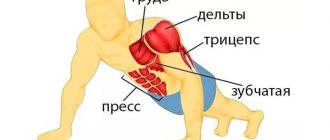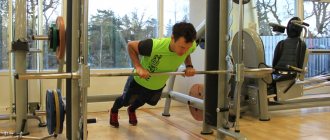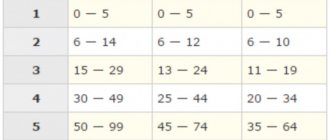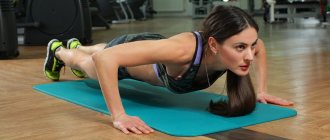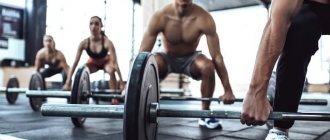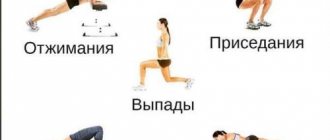Push-ups for the pectoral muscles
Push-ups are a basic exercise for working the pectoral muscles. In addition to the chest, triceps and anterior deltoids are actively involved in the work. And if you perform a lot of repetitions, the back muscles are actively involved in the work.
There are quite a few options for push-ups for beginners:
- Classic.
- With legs on support.
- With hands on support.
At the same time, you can perform this exercise with both wide and close placement of your hands. In the first version you pump up the chest, and in the second - the triceps.
Technique for performing push-ups:
- Take a lying position. Place your hands slightly wider than your shoulders.
- Keep your back straight, do not lift your buttocks. Your body should describe a straight line.
- Look forward, don't lower your head down.
- Lower yourself smoothly, but do not touch the floor with your chest.
- At the bottom point, hold for 2-3 seconds to feel the tension in your pectoral muscles.
- Rise up with a powerful movement.
- At the top point, tighten your pectoral muscles. Don't stay long.
Now you might be wondering, is it worth fully extending your arms at the top? It depends on what muscles you want to train. If you only need to work the pectoral muscles, then you should not fully extend your arms. But if you don't mind the triceps getting tense, you can straighten your arms completely. However, this will result in you being able to do fewer reps per set. So, if you are working on the number of repetitions, you should not extend your arms completely.
Push-ups are completely identical to the bench press. After all, the target muscles in this exercise are the same as in the bench press. The corset muscles are also actively involved in the work, which will relieve you of back problems. The various push-up variations are also identical to incline presses.
For example, push-ups with legs supported are identical to bench presses with barbells or dumbbells at an upward angle. The main load in this exercise falls on the front deltoids and upper pectoral muscles. This version of the exercise is more difficult than the classic one.
Push-ups with hands on a support are easier to perform than classic push-ups. If your fitness level is fairly high, you can easily perform several dozen of these push-ups. The main load here falls on the lower part of the pectoral muscles. This option is suitable for beginners. And those who are already able to do more than 30 push-ups should replace this option with deep push-ups. For this you will need two chairs.
This version of push-ups is performed as follows:
- Place two chairs opposite the bed.
- Starting position - your feet are on the sofa and your hands are on the chairs.
- Your task is to perform classic push-ups.
- The difference here is that there is no floor underneath you and you can push up deeper.
A larger range of motion increases the effectiveness of your workouts. Deep push-ups are identical to dips. The main load falls on the middle and lower part of your pectoral muscles. Thus, after performing these push-ups, your chest will appear barrel-shaped.
These were simple push-up variations that were accessible to people of all fitness levels. In a few weeks of training, anyone can master all these variations and be able to do more than 30 push-ups per set. What should those who are already tired of doing push-ups do many times? To do this, there are more difficult options for performing this exercise.
Let's start with the fact that you can move your hands both forward and backward. That is, first you need to get into the starting position of classic push-ups. After this, move your hands 15-20 centimeters forward. Notice that it has become harder for you to stand. And it will also be harder for you to do push-ups. In classic push-ups, the upper chest is almost not involved. And this movement of the arms forward helps to awaken the “dormant” fibers in the area of the upper chest.
If you move your hands a little back, that is, closer to your waist, it will be very difficult for you to do push-ups. You're doing great if you can do at least 10-15 of these push-ups per set. They look like this:
With these push-ups, your front deltoids and triceps will be contracted from a completely different angle, and this will help you increase them. The main thing is to warm up well.
Once you can perform over 50 classic push-ups with perfect form in one set, you should try the one-arm push-up. This does not mean that the load will be twice as much as with classic push-ups. It will be much larger, because the stabilizers and lower back will not participate in holding the body, and the active arm will be additionally strained.
By doing push-ups on one arm , you will pump up all the pushing muscles very well. Such workouts will load you up no worse than the bench press. Therefore, if you are gaining weight at home, be sure to do push-ups on one arm.
Any variation of push-ups has a powerful anabolic effect on your body. What does it mean? The anabolic effect is the stimulation of muscle growth. It occurs when you perform basic exercises due to the fact that the whole body is under load. The same thing happens with push-ups, because in addition to the pushing muscle groups, the whole body is under static load. And this perfectly stimulates the growth of your muscles.
Benefits of doing the exercise
The benefits of push-ups lie not only in working specific muscle groups. Push-ups of various types (classical, stand-up, parallel bars, etc.) are always included in the training process of martial artists, since their regular and intensive implementation increases the strength and speed of the blow, as well as the endurance of the muscles of the entire shoulder girdle, which is very important for a fighter of any level when working in full contact.
All of the above applies primarily to men. But what is the use of push-ups for women if they do not set themselves the goal of improving their fighting qualities or achieving hypertrophy of the pectoral muscles and triceps? Regularly performing push-ups consumes a large number of calories, which will be a kind of assistant in losing weight.
According to research, 30 push-ups burn about 60-80 calories. For comparison, 100 grams of boiled chicken breast contains 113 calories, and 100 ml of Coca-Cola contains 43 calories.
As a result of doing push-ups, metabolism improves and the lipolysis process proceeds much faster. Local load on the chest and triceps will visually improve muscle relief and “tighten” these areas, which is especially important for women during the recovery period after childbirth and breastfeeding. Regular push-ups will help remove excess accumulated fatty tissue and get rid of cellulite on your arms, which will only emphasize your athletic shape.
In addition, push-ups are an excellent way to prevent arthritis and bursitis. Studies show that subjects with early-stage arthritis performed 80 push-ups daily for four weeks, as a result of which almost 75% of them noted an overall improvement in well-being and the disappearance of pain in the joints.
Common Mistakes
Each exercise has specific performance characteristics that are important to follow. Most often, when doing push-ups, people make the following mistakes:
- High lifting of the pelvis, or lowering of the abdomen. By relaxing your back during push-ups, you reduce the range of motion. And this reduces the effectiveness of the training.
- The emphasis on your wrists will lead to injury to them. When you do push-ups, remember that you need to distribute the load evenly. The wrists are the fulcrum and the target muscle is the chest. Therefore, you should not remove the load from the chest and transfer it to the wrists for the sake of more repetitions.
- Many people do push-ups with a short amplitude. This is wrong, because, in addition to not really straining any muscles, you are wasting energy. If you push up to parallel or higher, it's wrong. The amplitude must be full. At the lowest point, there should be 1 centimeter left from your chest to the floor.
- Doing this exercise too fast will likely injure your shoulders and elbows. It is necessary to maintain an average pace. You spend 1-2 seconds at the bottom and top points. You also go down and up within two seconds.
- You give up too quickly. If your goal is to max out reps, then you need to take breaks during the set. For example, you've done 30 push-ups and you feel like your chest, arms and shoulders are starting to get really hot. To do this, stop and just stand in a prone position for 10-15 seconds. Once your pushing muscles have relaxed, you can continue doing push-ups. To use this technique, you need to regularly train the corset muscles.
- Many people hang their heads down. There is no need to do this, since your spine is very tense during push-ups. And lowering the head, and even more so rotating the head, can injure the cervical vertebrae. Especially if you haven't warmed up well.
- Neglecting quality for quantity. If you do push-ups many times, but with the wrong technique, it won't make any sense. When it comes to the number of repetitions, this means that they are performed without violating the technique. Therefore, before you start working on quantity, work on the correct technique for performing push-ups.
Common mistakes when doing push-ups
There are several mistakes that all beginners make at first. Let's look at each of them in detail.
Hands too wide
Many athletes believe that by placing their arms wider, they will shift more of the load to the pectoral muscles. This is partly true, but at the same time you will increase the load on your shoulder, elbow joints and ligaments many times over, which can lead to serious injury in the long run.
Incorrect elbow placement
Push-ups are not the same as dips. Here you will not be able to better load your chest by turning your elbows in different directions, but you are almost guaranteed to injure yourself.
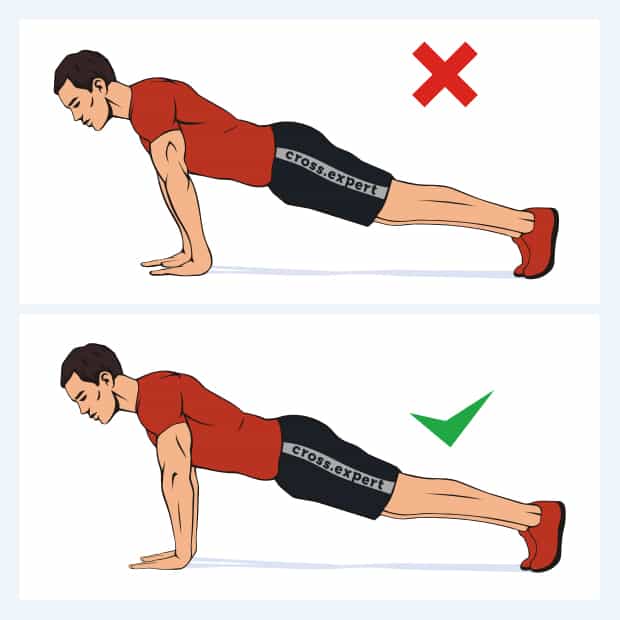
Incorrect (incomplete) range of motion
If it is difficult for you to do push-ups at full amplitude due to insufficient physical training, it is better to hold off on this exercise for now. Remember: at the bottom, your arms should be bent at an angle of 90 degrees, only then you can get the maximum benefit from push-ups.
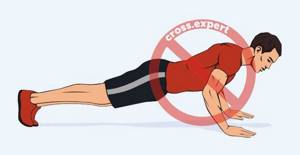
Back arch
A straight back is the main condition for performing push-ups correctly. The slightest deflection will immediately create a strong axial load on the spine. If you find it difficult to keep your back straight throughout the entire approach, you should additionally train your spinal extensors and abdominal muscles.

And in conclusion, we suggest watching a video that shows the errors described above.
Push-up programs
There are quite a few training programs for working out your body at home. Now we will bring to your attention several programs designed for athletes of different levels. You will also get acquainted with the push-up program to increase muscle mass.
For beginners
- Classic push-ups - 3 sets as many times as possible.
- Push-ups with hand support - 2 sets for the maximum number of times.
For advanced
- One-arm push-ups - 2 sets of maximum reps.
- Deep push-ups - 4 sets for maximum reps.
- Push-ups with close hands - 3 sets for a maximum of reps.
For gaining muscle mass
- One-arm push-ups - 4 sets of 8-10 reps.
- Classic push-ups - 4 sets of 8-10 reps.
- Push-ups with narrow hand position - 4 sets for the maximum number of times.
As you know, in order to increase muscle mass you need to exercise with additional weight. In this case, you need to take such a weight that you can do no more than 10 times per approach. One-arm push-ups are included in the mass program, since you are unlikely to do more than 10 times in one approach. Only professionals can do this. After this comes the classic version of push-ups . The program assumes that you will be working with additional weight. Anything will do for this. For example, you can put dumbbell discs or bottles of sand in your backpack. Some people get more sophisticated and put their little brother or sister on their back.
Lastly, you need to perform the variant with a narrow position of the hands. This is necessary for working the triceps. Here, additional weight will not be needed, because your muscles will be thoroughly tired after performing the previous exercises, and you will not be able to do more than 10 push-ups.
By the way, we can’t help but mention the table of push-ups. It looks like this:
This table shows a training plan, following which you can quickly increase the number of push-ups per set.
It is necessary to practice each of the complexes proposed above 2-3 times a week.
GTO standards for push-ups
Push-ups are a mandatory part of the state GTO program. For men and women, the number of push-ups is, of course, different. The difference in the number of repetitions also varies depending on the age group of the athlete. Each badge has different standards. The lower table contains the current GTO standards for push-ups.
Men
| Age | Number of repetitions per: | ||
| Bronze badge | Silver badge | Gold badge | |
| 6-8 | 7 | 9 | 17 |
| 9-10 | 9 | 12 | 16 |
| 11-12 | 12 | 14 | 20 |
| For boys from 13 to 18 and men from 18 to 39 years old, there are no standards for push-ups due to their simplicity; for them, pull-ups on the horizontal bar and weight snatch are mandatory. For men over 40 years of age, there is a single standard; there is no differentiation by level of training. | |||
| 40-44 | 30 | ||
| 45-49 | 28 | ||
| 50-54 | 25 | ||
| 55-59 | 20 | ||
| 60-69 | 10 (with emphasis on the gymnastic bench) | ||
| 70+ | 8 (with emphasis on the chair seat) | ||
Women
| Age | Number of repetitions per: | ||
| Bronze badge | Silver badge | Gold badge | |
| 6-8 | 4 | 5 | 11 |
| 9-10 | 5 | 7 | 12 |
| 11-12 | 7 | 8 | 14 |
| 13-15 | 7 | 9 | 15 |
| 16-17 | 9 | 10 | 16 |
| 18-24 | 10 | 12 | 14 |
| 25-29 | 10 | 12 | 14 |
| 30-34 | 6 | 8 | 12 |
| 35-39 | 6 | 8 | 12 |
| For women over 40 years of age, there is a single standard; there is no differentiation by level of training. | |||
| 40-44 | 12 | ||
| 45-49 | 10 | ||
| 50-54 | 8 | ||
| 55-59 | 6 | ||
| 60-69 | 6 (with emphasis on the gymnastic bench) | ||
| 70+ | 5 (with emphasis on the chair seat) | ||
Important Tips
Before starting classes, you need to warm up properly. First, you need to get your body into working condition. This means you need to increase your heart rate to 120-140 beats per minute. Secondly, after this you need to do warm-up exercises for the shoulder, wrist and elbow joints.
Plan your training program so that it is varied. The training process should be interesting and bring you joy. If it is monotonous and boring, then the result will be significantly lower. Moral satisfaction from training also plays a big role.
If you are a beginner athlete, then you need to exercise once a week. When you start to feel that this is not enough for you, gradually increase the frequency of exercise. To achieve maximum efficiency, three workouts per week will be enough.
Push-ups are one of the most effective exercises you can do at home. A lot of people study at home. By performing this exercise exclusively , they achieved impressive results. This means that you can achieve the same heights. The main thing is regular training and constant physical activity.
In conclusion, I would like to wish you good luck! If you find it difficult to overcome yourself and force yourself to train, do not torture yourself. Instead, make push-ups your morning habit. Firstly, you will wake up faster. Secondly, there will still be a positive result, because your body does not care what time of day the physical activity took place. I wish you success!
Harm of push-ups and contraindications
Despite the fact that push-ups are technically quite simple and at the same time effective exercise, not everyone will benefit from it. If you have chronic joint diseases, such as arthrosis, arthritis, bursitis, push-ups are contraindicated for you, as they can aggravate the symptoms of the disease at any time. Also, during push-ups from the floor, an axial load is created on the spine, so athletes suffering from hernias, protrusions and curvatures of the spine should be no less careful.
You should not rely on push-ups and other exercises performed with your own weight if you are overweight. You obviously don’t need any extra stress on your elbow joints. A much more rational way would be to gradually lose excess weight using a balanced diet and cardio exercise, while at the same time toning your muscles using isolated exercises on special machines.
Any harm that this exercise could potentially entail is in one way or another associated with a violation of the correct technique. Therefore, if you feel discomfort while performing push-ups, then look for the reasons for this in the next section.
Options for ready-made complexes for everyone
For a month: table for 30 days
| Day | 1 | 2 | 3 | 4 | 5 | 6 | 7 | 8 | 9 | 10 |
| Quantity | 5 | 5 | Rest | 5 | 10 | Rest | 10 | Rest | 12 | 12 |
| Day | 11 | 12 | 13 | 14 | 15 | 16 | 17 | 18 | 19 | 20 |
| Quantity | Rest | 15 | 15 | Rest | 20 | 24 | Rest | 25 | 30 | Rest |
| Day | 21 | 22 | 23 | 24 | 25 | 26 | 27 | 28 | 29 | 30 |
| Quantity | 32 | 35 | 35 | Rest | 38 | 40 | Rest | 42 | 45 | 50 |
6-week training: push-ups from zero to 100
This training option involves training 3 times a week with an interval of 24 hours for complete muscle relaxation. The daily norm of push-ups is divided into 5 approaches and gradually increases every week.
| Week 1 | Approaches | ||||
| Push ups | 4 | 5 | 4 | 4 | 5 |
| Week 2 | |||||
| Push ups | 5 | 7 | 5 | 5 | 8 |
| Week 3 | |||||
| Push ups | 11 | 13 | 9 | 9 | 13 |
| Week 4 | |||||
| Push ups | 16 | 18 | 13 | 13 | 20 |
| Week 5 | |||||
| Push ups | 13 | 15 | 12 | 10 | 30 |
| Week 6 | |||||
| Push ups | 13 | 17 | 16 | 14 | 50 |
Important! After completing 6 weeks of training, take a break for 2 days and do 100 push-ups. Thanks to the gradual increase in load, you will be able to complete this norm of repetitions and even more.
Up to 100 in 10 weeks
| A week | Day | ||||||
| Monday | Tuesday | Wednesday | Thursday | Friday | Saturday | Sunday | |
| 1 | 5×1 | 5×1 | – | 4×2 | 4×2 | – | 4×3 |
| 2 | 5×2 | 5×2 | – | 4×3 | 4×3 | – | 4×4 |
| 3 | 4×5 | 4×6 | 4×6 | – | 3×8 | 3×9 | 3×10 |
| 4 | – | 2×12 | – | 3×10 | – | 4×8 | – |
| 5 | 2×15 | 2×16 | – | 3×15 | 3×15 | – | 4×10 |
| 6 | 2×20 | 2×22 | – | 3×20 | 3×20 | – | 2×25 |
| 7 | 4×18 | 4×20 | – | 2×38 | 2×40 | – | 3×30 |
| 8 | – | 3×35 | – | 4×30 | – | 5×25 | – |
| 9 | 2×45 | 3×45 | – | 2×50 | 3×50 | – | 2×60 |
| 10 | 3×55 | 4×50 | – | 3×60 | – | 2×65 | 3×60 |
Note! Take a break for 24-48 hours and try doing 100 push-ups. If you follow such a training program, this will become possible - the body will already be adapted to such a muscular load.
20 week plan
| A week | 1 | 2 | 3 | 4 | 5 | 6 | 7 | 8 | 9 | 10 | 11 | 12 | 13 | 14 | 15 | 16 | 17 | 18 | 19 | 20 |
| Approach 1 | 20 | 25 | 30 | 35 | 40 | 40 | 45 | 45 | 50 | 50 | 55 | 60 | 60 | 65 | 65 | 70 | 70 | 75 | 75 | 80 |
| Approach 2 | 20 | 25 | 30 | 30 | 35 | 40 | 40 | 45 | 45 | 50 | 50 | 55 | 60 | 60 | 65 | 65 | 65 | 70 | 70 | 75 |
| Approach 3 | 15 | 20 | 25 | 25 | 25 | 30 | 35 | 35 | 35 | 40 | 40 | 40 | 45 | 45 | 45 | 50 | 50 | 55 | 55 | 55 |
| Approach 4 | 15 | 15 | 20 | 20 | 25 | 30 | 35 | 35 | 35 | 40 | 40 | 40 | 45 | 45 | 45 | 50 | 50 | 55 | 55 | 55 |
| Approach 5 | 10 | 10 | 15 | 15 | 15 | 20 | 25 | 25 | 30 | 35 | 35 | 35 | 40 | 40 | 40 | 40 | 45 | 45 | 50 | 50 |
| Total | 80 | 95 | 120 | 125 | 145 | 155 | 180 | 185 | 195 | 215 | 220 | 230 | 250 | 255 | 260 | 275 | 280 | 300 | 305 | 315 |
Note! This version of the sports program is suitable for experienced athletes who want to improve their fitness, increase muscle strength and endurance.
How to create a cool individual training program yourself
To create a training plan based on push-ups, you should look at the presented variations of this exercise.
Classic option . The traditional exercise technique is familiar from physical education lessons:
- Do a lying position.
- Place your palms slightly wider than your shoulders.
- The neck should be an extension of the back; you should not tilt or throw your head back too much.
- The legs are placed at a minimum distance, with their toes resting on the floor surface.
- Taking a deep breath and bending your elbows, lower your chest down.
- As you exhale and return to your previous position, fully straighten your arms.
This technique of performing this exercise activates the pectoral muscles, triceps and deltoids. Additionally, housing stabilizers are connected to the work. This exercise can become the basis for a regular training program.
Focus on the pectoral muscles . To pump this zone, it is necessary that during push-ups the arms (shoulders) are brought together towards each other. This movement is the main direction when working the pectoral muscles. This technique is reminiscent of similar chest exercises: bench press, crossover, chest press, etc. Push-ups with your arms as wide as possible will engage your chest to the greatest extent.
Features of the distribution of power load over individual muscles depend on the position of the body:
- hands and legs below - the middle of the chest is involved;
- the legs are placed on a slight elevation (a low bench or a special step) - the top of the pectoral muscles is loaded. However, with a large elevation, the shoulders are involved in the work, for this reason, observe moderation;
- hands on any elevation - the lower chest is fully involved. However, as the height of the support increases, the total load decreases, because body weight presses on your legs.
The effectiveness of muscle training depends on the overall amplitude of sports movements. The degree of total muscle contraction in the positive phase and stretching during the negative determines the intensity of the load. To stretch the pectoral muscles at the lowest point as efficiently as possible, you need to use special hand rests. They allow you to lower your body much lower than the standard length of men's arms allows. In the absence of special equipment, analogues of stops can be any 2 most convenient objects on which you can comfortably rest your hands.
The triceps almost always work with varying intensity during push-ups. However, the triceps are not the strongest and largest muscles in the human body. When it is possible to share the overall load with another department (for example, the chest), they constantly take advantage of it. To properly train the back of the arms, the chest should be “excluded” from the exercise as much as possible. For this reason, when doing triceps push-ups, the hands are removed. The palms are not placed wide on the floor, approximately level with the shoulders or much narrower (palms touching is allowed). And during the movement itself, the elbows are moved along the body, and not to the sides.
Note! When performing push-ups with a narrow grip, the triceps muscles of the shoulders are best activated. There is also another type of exercise for triceps - reverse push-ups. With this technique, the hands should be placed on the bench behind the body.
To strengthen the shoulders. With the help of a special type of push-ups, it is possible to significantly pump up the middle and front parts of the deltoid muscles. For this purpose, it is necessary to raise the pelvic area and legs to a high point (an extreme option is to stand head down on your hands and press your weight off the floor). Also, inclined and vertical versions of push-ups in the rack are aimed at the full development of the shoulders. You should take on this type of training exercise only when you have mastered the previous variations for the chest and triceps. It is extremely difficult to support your own weight on one hand, compared to the classic emphasis. During vertical push-ups, both legs should be placed high on a support (for example, a wall).
Load on fists, hands . The push-up options discussed above significantly expand the range of training, but this exercise can strengthen not only large muscle groups. One additional option is targeted strengthening of the hands and fingers. This action will be useful for those who engage in various martial arts or other sports that involve striking with fists, palms, etc.
Activation of explosive force . This type of strength is the ability to accomplish the maximum amount of work in a minimum period of time. This quality is urgently needed by athletes during training in CrossFit and other strength disciplines. Explosive strength ligaments are focused on greater endurance and well-developed muscles. These types of push-ups include clapping combinations, a special Spartan technique (one of the hands should be placed slightly in front, and the other behind, in order to change position while jumping). Other variations are also possible, which involve a dynamic change in body position when performing the main movement.
